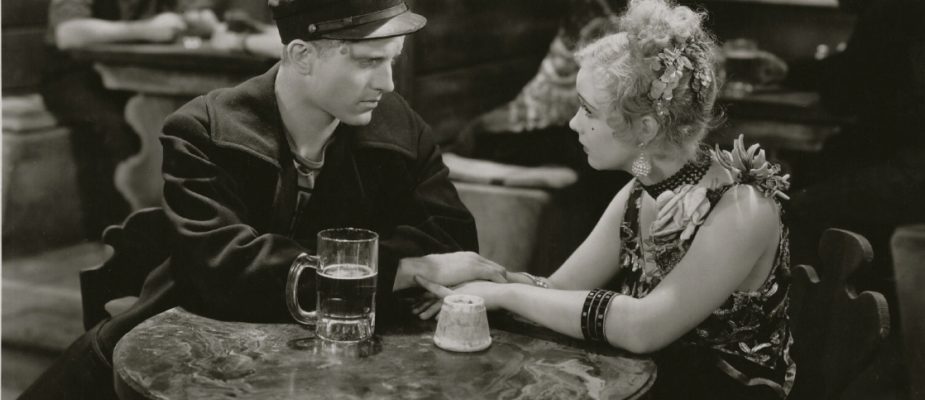Before I introduce the next two months of Museum Films programming at OKCMOA, let me first offer a few enthusiastic words for Tay Garnett’s Her Man (1930), which screened in newly restored 4K last night in the Noble Theater. Produced in the very early years of sound synchronization, at a time when the expressive camerawork of silent film’s late-twenties decadence had largely given way to static, sound-stage set-ups, director Garnett (The Postman Always Rings Twice) and his cinematographer Edward Snyder’s camera strides and glides, craning through the film’s disreputable gin joints, flop houses, and back alleys. The camera travels with the film’s lowlife cast of characters, and in one superlative example, the tin-plated tray that carries their spirits through the swarming space of the Thalia nightclub. It is a film, indeed, where the figures and more notably, the camera, consistently travels and moves forward through space–so much so that Her Man, in effect, makes an argument for cinema’s unique character among the visual arts, as a plastic art that presents physical movement. Her Man does the same with its deft manipulations of on and off-camera space, where the camera both discloses and withholds to dramatic effect, as when the film’s prime antagonist/villainous pimp Johnnie (a commendable Ricardo Cortez) tosses a knife in the back of a sex-trade rival off screen. Her Man’s camerawork, in other words, speaks not only to the expressive possibilities of film art, but also displays a sophisticated understanding of a cinematic space that includes both what the camera shows, and also what it hides again. This, once more, is largely a product of its spectacular movement through space, of a camera that does not sit back and observe action as if set back from a theatre stage–as again was so common in the very early sound era. Her Man is a marvel of mobile, long-take filmmaking and elegant framing; it anticipates not only the dizzying, subsequent experimentation of pre-Code Hollywood, but also the great European (cf. Jean Renoir and Max Ophüls) and Asian masterpieces that emerged later that decade.
Her Man is not all style and technical achievement. It is also a sweltering and exceptionally vivid love-triangle melodrama brought to life by Cortez and the film’s two flaxen lovebirds, petty thief/prostitute Frankie (Helen Twelvetrees) and sailor Dan (Phillips Holmes). Twelvetrees (her married name at the time) brings great allure, charm, and pathos to her tragic victim of circumstance; in one of the film’s most stirring moments, Dan arranges for Frankie to celebrate her birthday for the first time, after a life spent in dives like the Thalia, and without knowing the names of her parents or even her date-of-birth. Blowing out the nineteen matches with which Dan has decorated her cupcake, Frankie clicks her tongue in a throwaway gesture of jubilation that reveals the life that these performers give their down-and-out characters. Dan, on the other hand, is at once an instrument of audience desire in his pursuit of the comely young criminal, and is also a force and even object of spectacle in his own right: in a moment familiar to many 1930 features, he sings with his sailor friends; and, following a stem-winding fight- scene that culminates in Johnnie’s comeuppance, we see the cut young hero Dan’s striped sailor’s shirt ripped to smithereens. As is true of so many of the best films from Hollywood’s most invigoratingly disreputably moment, Her Man is a fantastically bizarre mash-up of various forms of excess.
Let me stop right there except to say that I sincerely hope the Oklahoma City reader was one of the more than fifty in attendance last night to see this marvelous example of wildly inventive pre-Code filmmaking. If not, at least the extremely belated reappearance and 4K digital restoration of Garnett’s masterpiece gives us reason to believe that this lost gem of the early sound cinema will finally surface, amazingly for the first time, on home video. For more on Her Man, see R. Emmet Sweeney’s contextualization and analysis at Movie Morlocks, TCM’s film criticism website.
***
Don’t despair–too much, you should despair a little–if you missed Her Man: Museum Films is also presenting two of Taiwanese martial arts maestro King Hu’s more entertaining masterworks, Dragon Inn (1967) and A Touch of Zen (1971), also in 4K digital. A Touch of Zen famously inspired Crouching Tiger, Hidden Dragon’s treetop ballet, while Dragon Inn provided the namesake (and appears in the background) of my own favorite film of the 2000s, Goodbye Dragon Inn (2003). August also brings, among other titles, tonight’s rousing double-feature of Raiders!: The Story of the Greatest Fan Film Ever Made and Raiders of the Lost Ark: The Adaptation, with a guest Skype Q&A featuring Indy himself, Chris Strompolis; deadCenter audience favorite, Hunt for the Wilderpeople, directed by What We Do in the Shadows’s Taika Waititi; the latest from art-house animation spet GKids, Phantom Boy; and an exploration of our current technological landscape, Lo and Behold, Reveries of the Connected World, conceived and narrated by the most distinctive “voice” in documentary, Werner Herzog.
Museum Films opens September with the top prize-winner at the 2015 Locarno Film Festival, and one of my own choices for the past year’s ten best, Right Now, Wrong Then, directed by the Piet Mondrian of the Korean art-house cinema, Hong Sang-soo; later on, we also will be bringing Oklahoma audiences My Love, Don’t Cross That River, a sentimental and moving documentary juggernaut that broke records in Hong’s native country of South Korea. September also features a tribute to the recently deceased Abbas Kiarostami with The Wind Will Carry Us (1999), the late, great Iranian master’s rumination on the human soul (and one of the best films of the prior two decades); easily one of the better American indies of 2016, Ira Sach’s wise and touching Little Men; and Italian auteur Nanni Moretti’s latest critical favorite, Mia Madre, which co-stars John Turturro.
Finally, and most exciting for me personally, is Museum Film’s original program of six new features from the world’s most populous nation, “Marginal Geographies: Independent Masterworks from China,” which opens with Kaili Blues (2015) on September 22. As I will write more in this space about this extraordinary program of fresh discoveries next month, let me simply point out that with the opening night film, Kaili Blues, we once again encounter a breathlessly inventive use of the moving camera.










